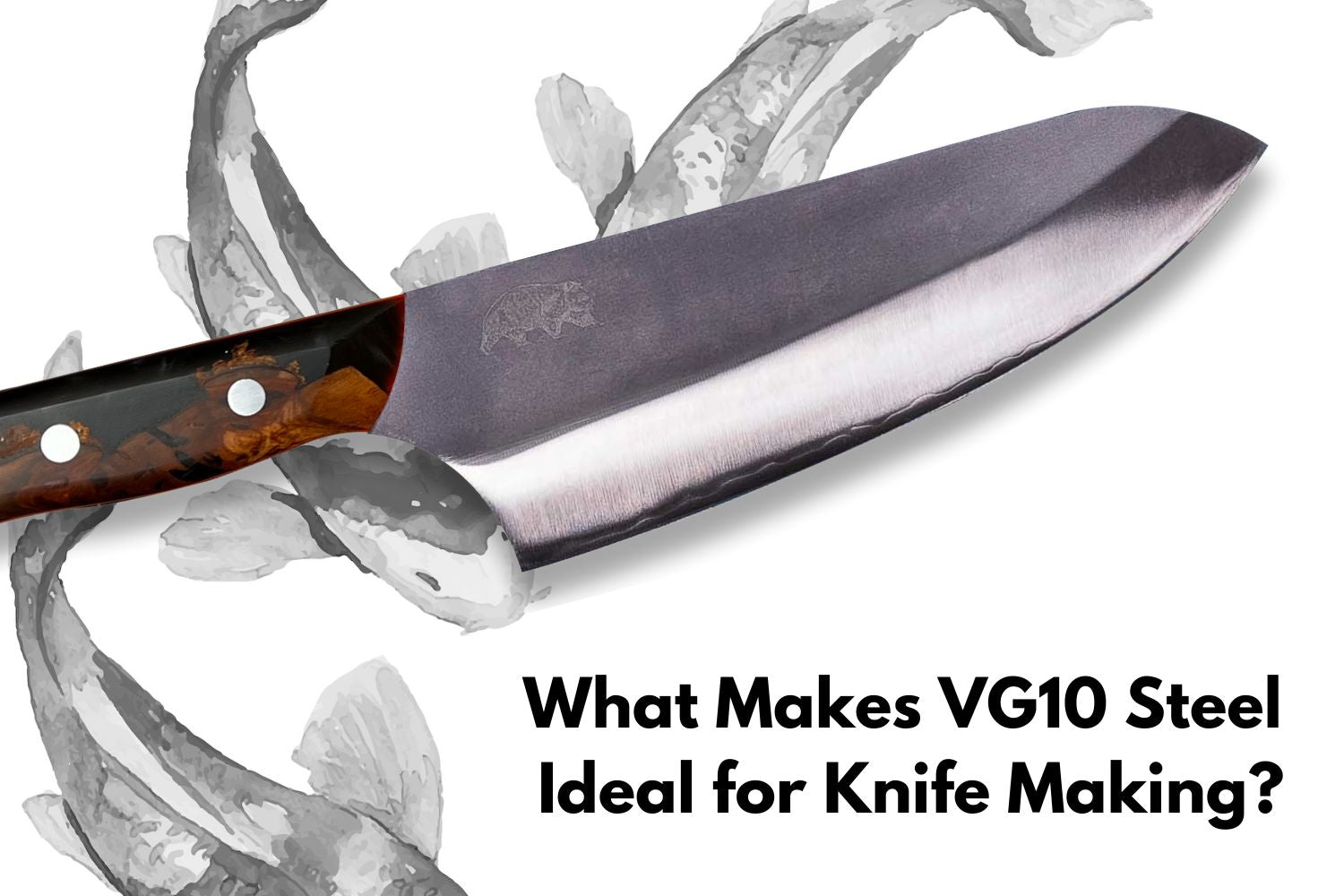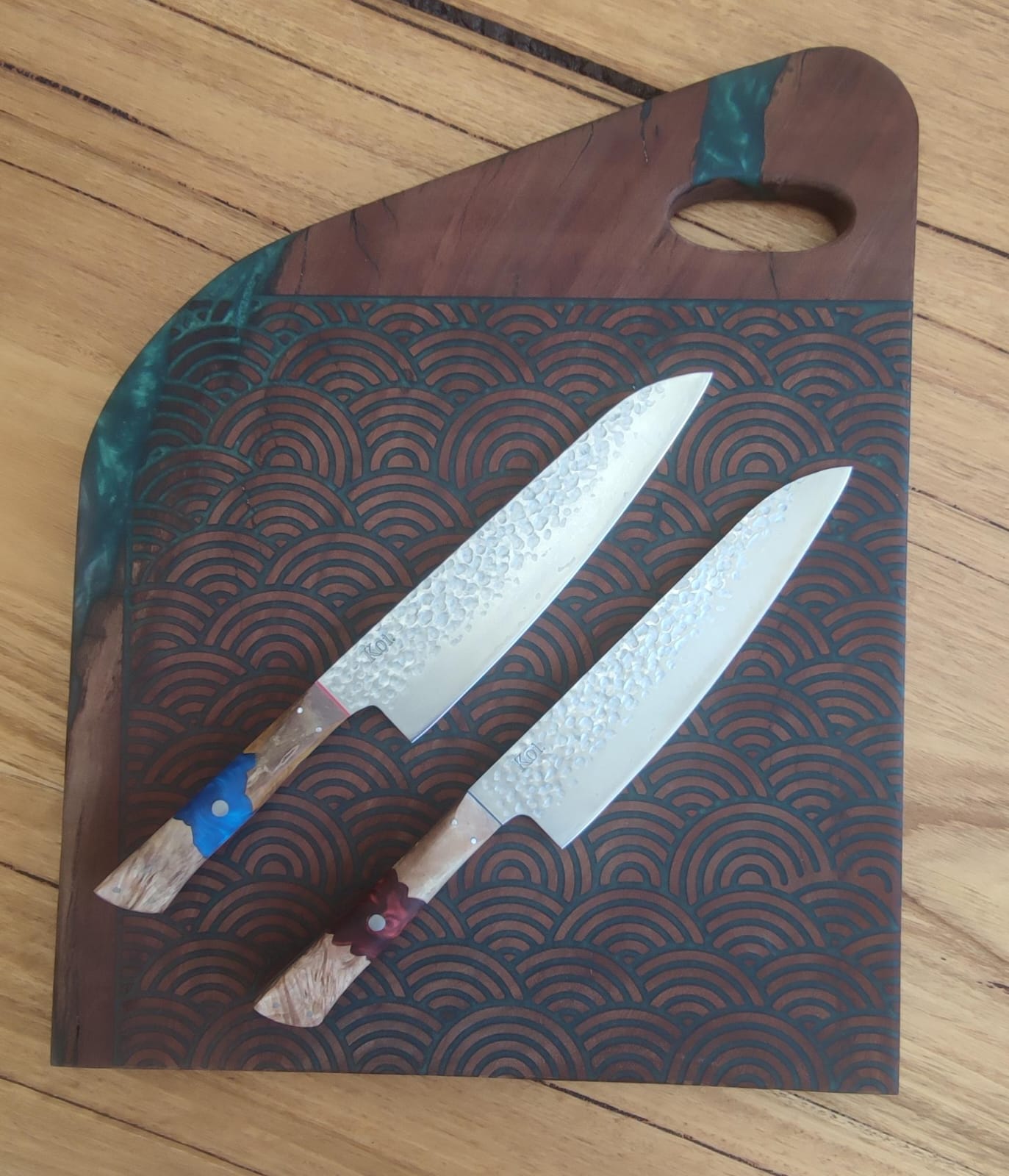VG10 is stainless steel from Takefu, Japan. Given the high requirements it fulfils, the "G" is an abbreviation for "Gold," and the "10" distinguishes it from VG1, its predecessor. Because of its high carbon content (1%), VG10 is superior steel for knife blades.
Check out our Koi range here
VG10 stainless steel is used to produce culinary, hunting, combat, and switchblades thanks to its edge durability qualities and good corrosion tolerance. In Japan, it is used to create chef's knives. The VG10 is also frequently used by labels outside of Japan too.
Are you interested in learning more about VG10 steel? Fortunately, we have researched extensively to collect as much information as possible regarding VG10 stainless steel. We'll help to tackle the various questions you might have, such as:
- What is VG 10 steel?
- Does it rust?
- How hard is it?
- Its chemical structure
- Ease of sharpening?
Want to see VG10 Steel in the flesh? Come into our store on Goodwood Road in Adelaide and see our range.
Or if you're a little further away, click here to view our products online.
VG10 Steel: What Is It?
VG10 is strong stainless steel first produced more than six decades ago and is being produced in Japan's Fukui region by Takefu Special Steels. VG10, a highly-alloyed, high-carbon knife material, is now being produced by many producers and has created numerous jobs.
This steel type is also known as V-kin-10, Japanese for V "Gold" 10. In some languages, a "G" has replaced the word "kin." In this context, the term "gold" refers to the standards that this metal has attained and the results it produces.
Initially only used to make blades for Japanese chefs, but because of its superior quality and resilience, VG10 has become popular in most countries and industries, such as for compact and hunting knives.
Check out the video below to see our Dingo Knife (made with VG10 Steel) in action or click here for more information.
What Composes VG-10 Steel?
One of the most defining elements of VG10 steel is its 1% carbon content. Stainless steels have varying quantities of carbon, affecting their reliability and functionality. In comparison, typical 420 steel blades contain 0.38% carbon on average.
Of all, carbon is just one of the materials that go into making a tough, high-quality knife blade. The elements in VG10 steel and their roles are detailed below.
Carbon 0.95-1.05%
When combined with iron, carbon acts as a significant hardening ingredient in the blade. High-carbon steels have a carbon content greater than 0.8 percent.
Chromium 14.5-15.5%
If you've ever had a steel knife, you're aware that rust can be an issue. Chromium is what renders particular steel "stainless," as it boosts the material's tolerance to rust. Any metal with a Chromium content of over 12% is highly oxidation-resistant.
Molybdenum 0.9-1.2 %
Molybdenum improves the blade's ability to withstand extreme temperatures.
Vanadium 0.1-0.3 %
Another substance that helps strengthen the blade and boost its durability against tearing and scratching.
Cobalt 1.30-1.50 %
Hardens the steel
Manganese 0.5%
Manganese solidifies the blade. However, excessive additions may cause increased brittleness.
Key Characteristics of VG-10 Steel
VG-10 possesses distinctive qualities that have elevated it to the ranks of higher-rating steels in addition to the chemicals that make up its core. Indeed, due to its adaptability, balance, and simplicity of use, it has emerged as one of chefs' and cooks' preferred choices for kitchen knives.
Anti-rust Properties
VG-10 steel is durable and corrosion-resistant when kept in good condition. This characteristic is related to the stainless steel's high chromium content. On the blade's surface, this substance provides an oxide layer of protection. You can take advantage of VG-10's up to 15.5 percent chromium content.
Corrosion Resistance
Pitting corrosion can affect VG10 steel, which is less resistant to corrosion than rust. By making tiny holes along the surface, this kind of degradation might alter the knife's blade. However, improved corrosion resistance would compromise the knife's functionality. Even in this situation, routine maintenance is a must to avoid pitting corrosion.
Not Suitable for Dishwashers
As previously stated, VG10 steel is rust-resistant. This does not suggest that the material is entirely impervious to it. Dishwashing a stainless-steel knife can render it more susceptible to rust and corrosion and reduce its efficiency. Furthermore, the high temperature and chemicals used in dishwashers degrades handle construction, causing swelling in wood handles or tackiness in resin composite handles like G10 and Micarta.
Koi Advice
Don't put it in the dishwasher or leave it in a sink full of water as this can lead to corrosion. We also recommend against cutting on a glass chopping board as this is terrible for the blade (can lead to chipping).
Koi knives have a high carbon concentration meaning they are harder at the edge. This means less honing is needed (i.e. sharpening with your rod at home or in the kitchen).
With this type of steel you should have it sharpened by a sharpener (ideally on a whetstone to stop the steel heating). How often varies depending on usage however most people do it every 3-6 months.
If you need your knife or knives sharpened, come in to our Goodwood Road Store and we can sharpen them for you or provide you with the tools to try it yourself!
Click here to check out our range of sharpening tools online or book a sharpening class with our master sharpener Joao.

Edge Preservation
You might observe varied edge retention standards based on how you use your VG10 steel knife. VG10 steel is easy to hone and holds its sharp edge without trouble when used in the house or to chop softer materials.
Edge preservation is dictated by the HRC rating and the angle of the bevel (among other things). HRC of 60+ is considered a hard steel, and the increased strength and rigidity will preserve the edge for much longer than softer steels. Angle of the bevel is another important attribute. Any sharpening angle less than 14° degrees will increase the chances of micro-fractures, warping or chipping. We find angles between 15-18° degrees to be a good balance of strength and sharpness.
Differences Between VG-10 and VG-1
Both varieties are intriguing to consider if you enjoy traditional Japanese knives. Even so, you must be aware that there is a distinction between the two sorts if you are eager to utilise your knife regularly.
The VG-1 is the predecessor of the VG10 and the original model in Takefu Special Steel's stainless steel line. Both steels have high toughness, reduced impurity content, corrosion, rust, and water resistance.
However, the difference lies in the hardness of the material. VG1 steel has a hardness of 58 to 59 HRC, while VG10 reaches the higher tier, with a hardness level of 60 to 62 HRC.
What Metal Makes the Best Blade for a Knife?
Knives are formed from various materials depending on their intended purposes. Even though no one material matches all conditions, carbon stainless steel is unquestionably the most excellent material for knife blades.
Stainless steel is a carbon-added alloy. As a result, carbon stainless steels have the properties of both types of materials.
Carbon steel – the added carbon in the steel ensures the toughness and hardness of the blade. This compound makes the knife more durable and more comfortable to clean and sharpen. Pure carbon steel knives are considered the best for master chef's, but do require extra maintenance and caution when using.
Stainless steel – while carbon steel is exceptionally durable, it is susceptible to rusting. However, the added chromium in stainless steel blades makes it more resistant to oxidation and corrosion.
Conclusion
VG-10 steel is carbon-added stainless steel that was developed in Takefu, Japan. VG-10 is now one of the most used materials for chef knife blades due to its durability, hardness, edge retaining potential, and rust tolerance.
Some of its distinguishing features include:
- It contains more than 1% carbon.
- The chromium addition prevents rust from forming.
- Other unique hardening elements include vanadium, cobalt, and manganese.
If you want a high-quality material for a knife blade that will last the longest, look no further than the Gold standard of Japanese knife-making.






